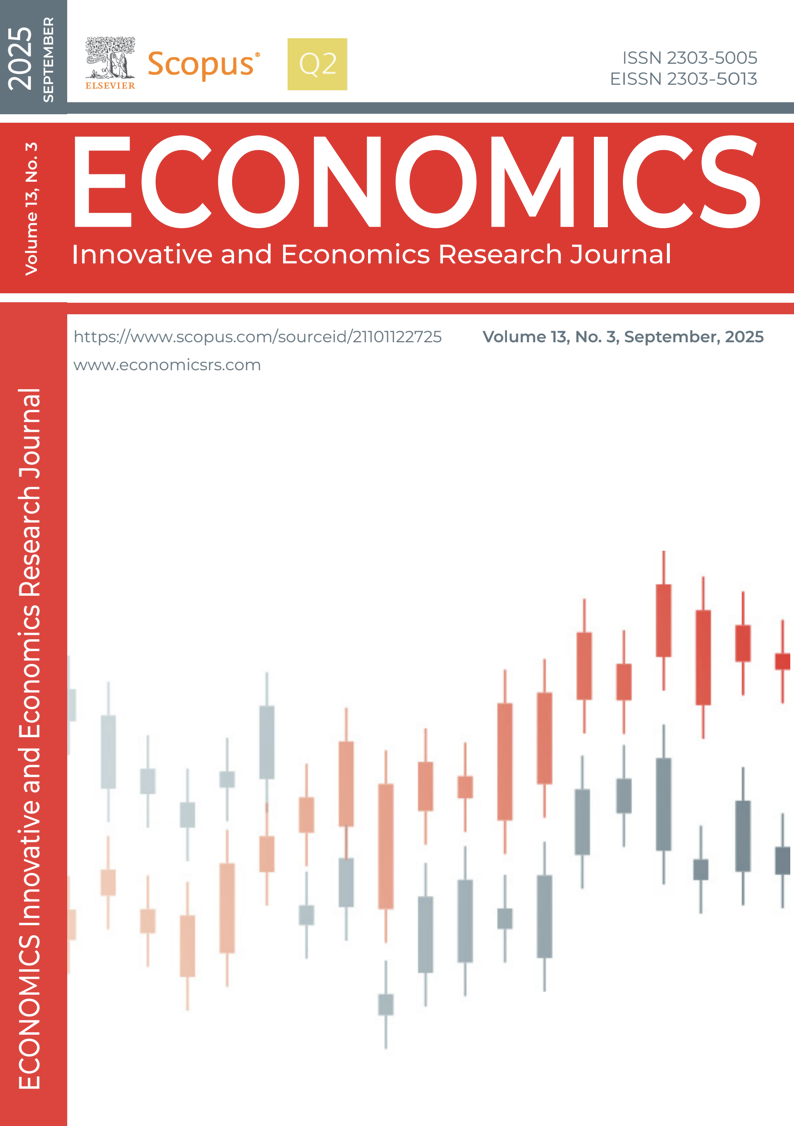EFFICIENCY ANALYSIS OF REGIONAL GOVERNMENT EXPENDITURE ON DEVELOPMENT: EVIDENCE FROM INDONESIA
DOI:
https://doi.org/10.2478/eoik-2025-0058Keywords:
Financial Efficiency, Fiscal Autonomy, Indonesian Democracy, Productivity, Regional Development, Trade OpennessAbstract
Regional governments are expected to be able to focus more on im-
proving the welfare of the community in optimizing government ad-
ministration in each region. This study aims to identify the factors
that influence regional development as indicated by the human devel-
opment index in that region. This study analyzes the efficiency level,
productivity level, trade openness, degree of fiscal autonomy (DFA),
and democracy on regional development in Indonesia during the peri-
od 2016-2020. The effectiveness and efficiency of government budget
functions were evaluated using Data Envelopment Analysis. The re-
search model was evaluated using panel data regression with E-views.
Trade openness and Indonesian Democracy Index have a positive and
insignificant effect on Regional Development. The Degree of Fiscal
Autonomy has a negative and insignificant effect on Regional De-
velopment. Thus, the government needs to focus on the efficiency of
budget use and democracy in its region in order to optimize regional
development. This research also indicates that the level of the Degree
of Fiscal Autonomy in a region must be managed properly. DFA that
is too high can reduce the achievement of regional development in
general. Thus, governments have to pay attention to elevate the degree
of fiscal autonomy given to each region to spur economic growth.
References
Agrawal, D. R., Brueckner, J. K., & Brülhart, M. (2025). Fiscal Federalism in the Twenty-First Century.
On: Wed, 24, 50. https://doi.org/10.1146/annurev-economics-081623-020713
Akinyele, O. D. (2024). Assessing the determinants of human development in OECD economies: evi-
dence from labor productivity and investment decisions. Journal of Economic Studies, 51(8),
–1676. https://doi.org/10.1108/JES-10-2023-0596
Amate-Fortes, I., Guarnido-Rueda, A., & Molina-Morales, A. (2017). Economic and Social Determi-
nants of Human Development: A New Perspective. Social Indicators Research, 133(2), 561–
https://doi.org/10.1007/s11205-016-1389-z
Arcelus, F. J., Sharma, B., & Srinivasan, G. (2006). The Human Development Index Adjusted for
Efficient Resource Utilization. Inequality, Poverty and Well-Being, 177–193. https://doi.
org/10.1057/9780230625594_9
Arzaghi, M., & Henderson, J. V. (2005). Why countries are fiscally decentralizing. Journal of Public
Economics, 89(7), 1157–1189. https://doi.org/10.1016/j.jpubeco.2003.10.009
Badan Pusat Statistik. (2021). Human Development Index (Indeks Pembangunan Manusia) 2020.
https://www.bps.go.id/id/publication/2021/04/30/8e777ce2d7570ced44197a37/indeks-pemba-
ngunan-manusia-2020.html
Bareke, M. L., Agezew, B. H., Dedho, N. H., Lebeta, M. F., Demissie, M. M., Yimer, B. M., & Herut, A.
H. (2021). Determinants of Human Capital Development in Ethiopia: Implications to Education
Policy. Education Research International, 2021. https://doi.org/10.1155/2021/6619674
Barro, R. J. (1999). Determinants of democracy. Journal of Political Economy, 107(6 PART 2). https://
doi.org/10.1086/250107
Bunyaminu, A., Mohammed, I., Yakubu, I. N., Shani, B., & Abukari, A.-L. (2022). The effect of health expen-
diture on average life expectancy: does government effectiveness play a moderating role? Interna-
tional Journal of Health Governance, 27(4), 365–377. https://doi.org/10.1108/IJHG-03-2022-0027
Despotis, D. K. (2005). A reassessment of the human development index via data envelopment analysis. Journal
of the Operational Research Society, 56(8), 969–980. https://doi.org/10.1057/palgrave.jors.2601927
Enikolopov, R., & Zhuravskaya, E. (2007). Decentralization and political institutions. Journal of Public
Economics, 91(11–12), 2261–2290. https://doi.org/10.1016/j.jpubeco.2007.02.006
Fauzi, A. (2019). Regional autonomy framework for better regional government (Otonomi Daerah Da-
lam Kerangka Mewujudkan Penyelenggaraan Pemerintahan Daerah Yang Baik). Spektrum Hu-
kum, 16(1), 119. https://doi.org/10.35973/sh.v16i1.1130
Ferraz, D., Mariano, E. B., Rebelatto, D., & Hartmann, D. (2020). Linking Human Development and
the Financial Responsibility of Regions: Combined Index Proposals Using Methods from Data
Envelopment Analysis. In Social Indicators Research 150(2). Springer Netherlands. https://doi.
org/10.1007/s11205-020-02338-3
Fujii, E. (2019). What Does Trade Openness Measure? Oxford Bulletin of Economics and Statistics,
(4), 868–888. https://doi.org/10.1111/obes.12275
Gerring, J., Thacker, S. C., & Alfaro, R. (2012). Democracy and human development. Journal of Poli-
tics, 74(1), 1–17. https://doi.org/10.1017/S0022381611001113
Golub, S. S. (2009). Openness to foreign direct investment in services: An international comparative
analysis. World Economy, 32(8), 1245–1268. https://doi.org/10.1111/j.1467-9701.2009.01201.x
Gousario, F., & Dharmastuti, C. F. (2015). Regional Financial Performance and Human Development
Index Based on Study In 20 Counties/Cities of Level I Region. The Winners, 16(2), 152. https://
doi.org/10.21512/tw.v16i2.1568
Hardianto, A. M., Tjahjadi, B., & Narsa, I. M. (2017). Human Development Index (HDI) As a Planning
Plan for Dealing Globalization of Asean Economic Society (MEA) in Indonesia. Proceedings of
the ICECRS, 1(2), 108–115. https://doi.org/10.21070/picecrs.v1i2.1444
Paidi et al. / Economics - Innovative and Economics Research Journal, doi: 10.2478/eoik-2025-0058
Hendarmin, H., & Kartika, M. (2019). The Relationship Between Human Capital and the Regional
Economy Productivity. Jejak, 12(1), 138–152. https://doi.org/10.15294/jejak.v12i1.18396
Hidayat, P., & Sari, R. L. (2022). Linkage between financial inclusion and Indonesian welfare: a recent evidence.
Cogent Business and Management, 9(1), 0–12. https://doi.org/10.1080/23311975.2022.2108299
Hossain, R. (2022). The effects of foreign direct investment and trade openness on economic growth
amid crises in Asian economies. Economic Journal of Emerging Markets, 14(2), 217–229.
https://doi.org/10.20885/ejem.vol14.iss2.art7
Hye, Q. M. A. (2012). Exports, imports and economic growth in China: An ARDL analysis. Journal of
Chinese Economics and Trade Studies, 5(1), 42–55. https://doi.org/10.1108/17544401211197959
Irtyshcheva, I., Boiko, Y., Kramarenko, I., Voit, D., & Popadynets, N. (2022). Efficiency of Decentraliza-
tion as an Important Instrument of Ukraine’s Socio-Economic Development. International Journal
of Industrial Engineering and Production Research, 33(1). https://doi.org/10.22068/ijiepr.33.1.5
Jaba, E., Balan, C. B., & Robu, I.-B. (2014). The Relationship between Life Expectancy at Birth and
Health Expenditures Estimated by a Cross-country and Time-series Analysis. Procedia Econom-
ics and Finance, 15, 108–114. https://doi.org/https://doi.org/10.1016/S2212-5671(14)00454-7
Jaunky, V. C. (2013). Democracy and economic growth in Sub-Saharan Africa: A panel data approach.
Empirical Economics, 45(2), 987–1008. https://doi.org/10.1007/s00181-012-0633-x
Katti, S., Pratiwi, D., & Setiahadi, R. (2019). Klassen Typology Approach for Analysis of the Role of
Competitiveness Agricultural Sector. IOP Conference Series: Earth and Environmental Sci-
ence, 347(1), 0–11. https://doi.org/10.1088/1755-1315/347/1/012106
Krmpotic, D., Ileš, M., & Bicvid, D. (2020). The impact of fiscal autonomy on regional development
in the republic of croatia. 60th International Scientific Conference on Economic and Social
Development – XX International Social Congress (ISC 2020), October, 2020. https://www.pro-
quest.com/conference-papers-proceedings/impact-fiscal-autonomy-on-regional-development/
docview/2462680750/se-2
Kurniawan, I., & Murtala, M. (2020). Efisiensi Belanja Pemerintah Terhadap Indeks Pembangunan Ma-
nusia Secara Regional di Indonesia. Jurnal Ekonomi Regional Unimal, 3(3), 15–22. https://doi.
org/10.29103/jeru.v4i2.6051
Kurteš, S., Amidžić, S., & Kurušić, D. (2023). Impact of Trade Openness, Human Capital Through In-
novations on Economic Growth: Case of The Balkan Countries. ECONOMICS - Innovative and
Economics Research Journal, 11(2), 199–208. https://doi.org/10.2478/eoik-2023-0047
Liotti, G., Musella, M., & D’Isanto, F. (2018). Does democracy improve human development? Evidence
from former socialist countries. Eastern Journal of European Studies, 9(2), 69–88. https://ejes.
uaic.ro/EJES2018_vol9_issue2.htm
Liu, M., Gong, F., & Song, W. (2022). Like the new and hate the old: The impact of fiscal decen-
tralization on regional development strategy. PLoS ONE, 17(9 September), 1–23. https://doi.
org/10.1371/journal.pone.0273875
Martin, N. & Edalatpanah, S. A. (2023). Application of Extended Fuzzy ISOCOV Methodology in
Nanomaterial Selection Based on Performance Measures. Journal of Operational and Strategic
Analytics, 1(2), 55-61. https://doi.org/10.56578/josa010202
Mehmood, R., Sadiq, S., & Khalid, M. (2010). Impact of Fiscal Decentralisation on Human Development:
A Case Study of Pakistan. The Pakistan Development Review, 49(4), 513–530. https://pide.org.
pk/research/impact-of-fiscal-decentralisation-on-human-development-a-case-study-of-pakistan/
Mihaiu, D. M., Opreana, A., & Cristescu, M. P. (2010). Efficiency, effectiveness and performance of the
public sector. Romanian Journal of Economic Forecasting, 13(4), 132–147. https://ipe.ro/rjef/
rjef4_10/rjef4_10_10.htm
Monyela, M. N., & Saba, C. S. (2024). Trade openness, economic growth and economic development
nexus in South Africa: a pre- and post-BRICS analysis. Humanities and Social Sciences Com-
munications, 11(1), 1108. https://doi.org/10.1057/s41599-024-03604-2
Efficiency Analysis of Regional Government Expenditure on Development: Evidence from Indonesia
Mukti, H. K., & Auwalin, I. (2020). Analisis Efisiensi Pengeluaran Pemerintah Daerah Di Provinsi Jawa
Timur Terhadap Islamic Human Development Index (I-Hdi): Pendekatan Bootstrap Data En-
velopment Analysis (Dea) Dan Malmquist Index. Jurnal Ekonomi Syariah Teori Dan Terapan,
(1), 132. https://doi.org/10.20473/vol7iss20201pp132-140
Noorlaelasari, Y., Juarti, E. R., Rahman, A., & Juraida, A. (2023). Assessing Compliance to Minimum
Service Standards of Indonesian Toll Roads: An Examination of the Padaleunyi Toll Road. Jour-
nal of Urban Development and Management, 2(2), 84-94. https://doi.org/10.56578/judm020203
Nguyen, P. D., Vo, D. H., Ho, C. M., & Vo, A. T. (2019). Fiscal Decentralisation and Economic Growth
across Provinces: New Evidence from Vietnam Using a Novel Measurement and Approach.
Journal of Risk and Financial Management, 12(3), 143. https://doi.org/10.3390/jrfm12030143
Pasichnyi, M., Kaneva, T., Ruban, M., & Nepytaliuk, A. (2019). The impact of fiscal decentralization
on economic development. Investment Management and Financial Innovations, 16(3), 29–39.
https://doi.org/10.21511/imfi.16(3).2019.04
Pourmohammadi, M. R., Valibeigi, M., & Sadrmousavi, M. S. (2014). The relationship between hdi and
its indicators with regional growth in Iranian provinces. Regional Science Inquiry, 6(2), 73–86.
https://citeseerx.ist.psu.edu/document?repid=rep1&type=pdf&doi=3c1f51510b7466c0dddcd-
fbf05ca40d84875474#page=72
Qayyum, M., Younas, N., & Bashir, M. A. (2018). The Impact of Trade Liberalization on Economic
Growth: A case study of Pakistan. Journal of Economics and Sustainable Development, 9(9),
–71. https://doi.org/10.6007/ijarbss/v4-i5/879
Protsenko, I. (2023). Legal Status and Peculiarities of Taxation of E-Residents in Ukraine. Collection of
papers new economy, 1, 244-255. https://doi.org/10.61432/CPNE0101244p
Raith, A., Rouse, P., & Seiford, L. M. (2019). Benchmarking Using Data Envelopment Analysis: Appli-
cation to Stores of a Post and Banking Business. In International Series in Operations Research
and Management Science, 274. https://doi.org/10.1007/978-3-319-99304-1_1
Sabermahani, A., Barouni, M., Seyedin, H., & Aryankhesal, A. (2013). Provincial human development
index, a guide for efficiency level analysis: The case of Iran. Iranian Journal of Public Health,
(2), 149–157. https://pmc.ncbi.nlm.nih.gov/articles/PMC3595646/
Saha, S., & Zhang, Z. (2017). Democracy-Growth Nexus and its Interaction Effect on Human De-
velopment: A Cross-National Analysis. Economic Modeling, 63(June), 304–310. https://doi.
org/10.1016/j.econmod.2017.02.021
Saragih, J., Wardati, J., & Pratama, I. (2020). Trade openness, government development expenditures,
gross capital formation and economic growth: An ASEAN case. International Journal of Inno-
vation, Creativity and Change, 12(10), 366–383. https://www.ijicc.net/index.php/volume-12-
/176-vol-12-iss-10
Satyanarayana Murthy, D., Kumar Patra, S., & Samantaraya, A. (2014). Trade Openness, Financial De-
velopment Index and Economic Growth: Evidence from India (1971-2012). Journal of Finan-
cial Economic Policy, 6(4), 362–375. https://doi.org/10.1108/JFEP-10-2013-0056
Sow, M., & Razafimahefa, I. (2015). Fiscal Decentralization and the Efficiency of Public Service Deliv-
ery. IMF Working Papers, 15(59), 1. https://doi.org/10.5089/9781484351116.001
Spaiser, V., Ranganathan, S., Mann, R. P., & Sumpter, D. J. T. (2014). The dynamics of democracy, develop-
ment and cultural values. PLoS ONE, 9(6), 24–26. https://doi.org/10.1371/journal.pone.0097856
Tashkinova, O. (2023). The Traumatic Experience of the Mariupol Civilians’ Forced Migration and Adaptation
Abroad in 2022. Collection of papers new economy, 1, 89-109. https://doi.org/10.61432/CPNE0101089t
Tekin, B. (2020). The Nexus between Financial Development and Human Development: The Case of
Developing Countries. Journal of Emerging Economies and Islamic Research, 8(2), 73. https://
doi.org/10.24191/jeeir.v8i2.8735
Tumay, M. (2021). The Effect of Fiscal Decentralization on The Human Development Index and Its
Components: A Panel Data Study. Uluslararası Ekonomi ve Yenilik Dergisi, 7(2), 357–373.
https://doi.org/10.20979/ueyd.954645
Paidi et al. / Economics - Innovative and Economics Research Journal, doi: 10.2478/eoik-2025-0058
Udoh, E., Afangideh, U., & Udeaja, E. A. (2015). Fiscal decentralization, economic growth and hu-
man resource development in Nigeria: Autoregressive Distributed Lag (ARDL) approach. CBN
Journal of Applied Statistics, 06(1), 69–93. https://dc.cbn.gov.ng/jas/vol6/iss1/4/
Varona, L., & Gonzales, J. R. (2021). Dynamics of the impact of COVID-19 on the economic activity of
Peru. PLoS ONE, 16(1 January), 1–30. https://doi.org/10.1371/journal.pone.0244920
Vierstraete, V. (2012). Efficiency in human Development: a Data Envelopment Analysis. The European
Journal of Comparative Economics, 9(3), 425–443. https://ejce.liuc.it/Default.asp?tipo=arti-
cles&identifier=ejce:18242979/2012/03/05
Wang, F., Jin, M., Li, J., Zhang, Y., & Chen, J. (2022). Profound Impact of Economic Openness and
Digital Economy towards a Sustainable Development: A New Look at RCEP Economies. Sus-
tainability, 14(21), 13922. https://doi.org/10.3390/su142113922
Wang, G. N., Yang, Y. H., & Xu Y. J. (2024). Impact of Green Finance Reform and Innovation Pilot
Zones on Regional Economic Growth. J. Green Econ. Journal of Green Economy and Low-Car-
bon Development, 3(3), 161-172. https://doi.org/10.56578/jgelcd030302
Wichowska, A. (2021). The degree of fiscal decentralization in European Union countries in differ-
ent stages of the economic cycle. Entrepreneurship and Sustainability Issues, 9(2), 198–208.
https://doi.org/10.9770/jesi.2021.9.2(13)
Xu, L., Xue, H., & Wu, Q. (2022). The Impact of Development Zones on Economic Growth in Less Devel-
oped Regions: Evidence from Guangxi, China. Land, 11(10). https://doi.org/10.3390/land11101658
Zhang, T., & Zou, H. fu. (1998). Fiscal decentralization, public spending, and economic growth in China.
Journal of Public Economics, 67(2), 221–240. https://doi.org/10.1016/S0047-2727(97)00057-1
Downloads
Published
How to Cite
Issue
Section
License
Copyright (c) 2025 ECONOMICS - INNOVATIVE AND ECONOMICS RESEARCH JOURNAL

This work is licensed under a Creative Commons Attribution-NonCommercial-NoDerivatives 4.0 International License.























